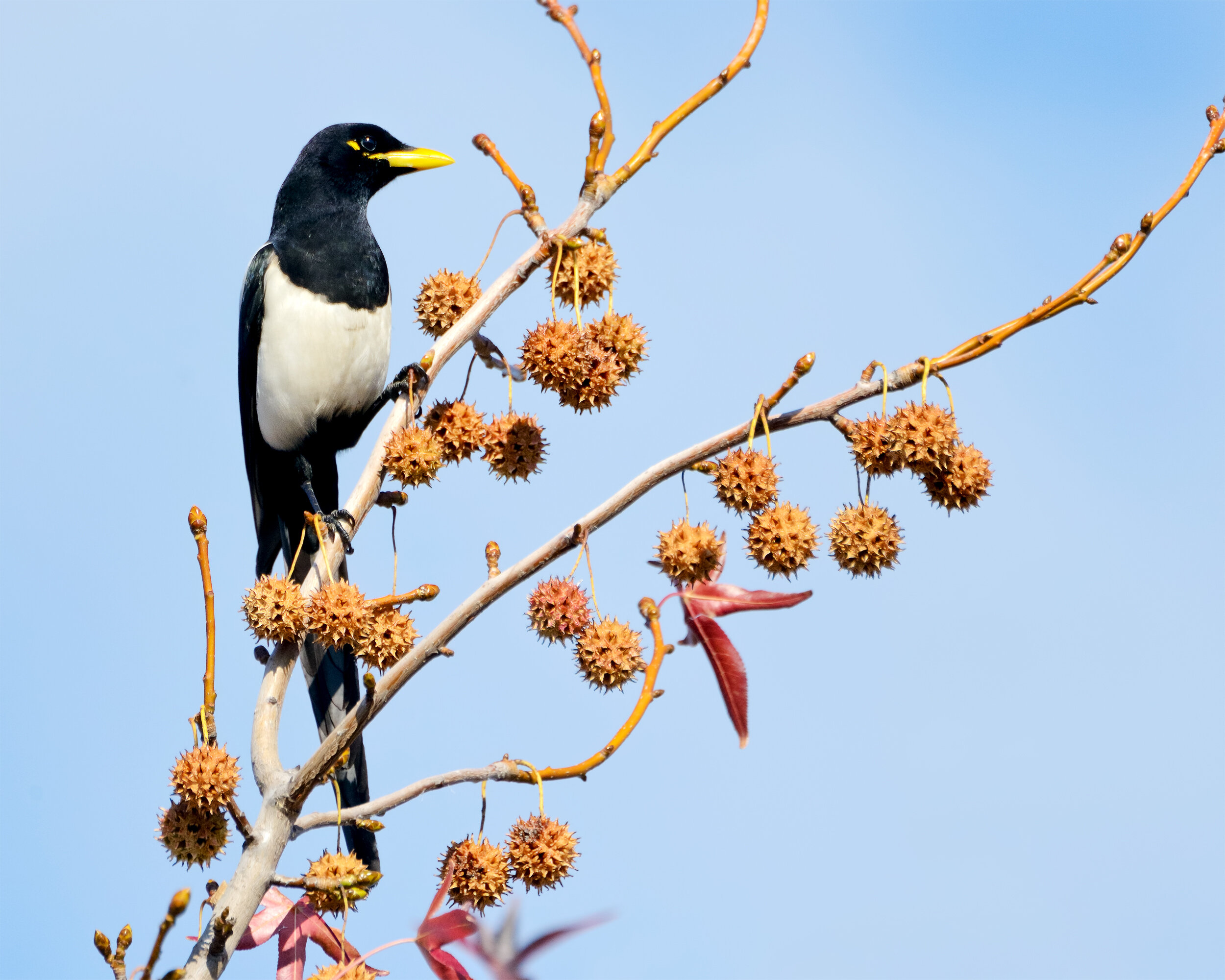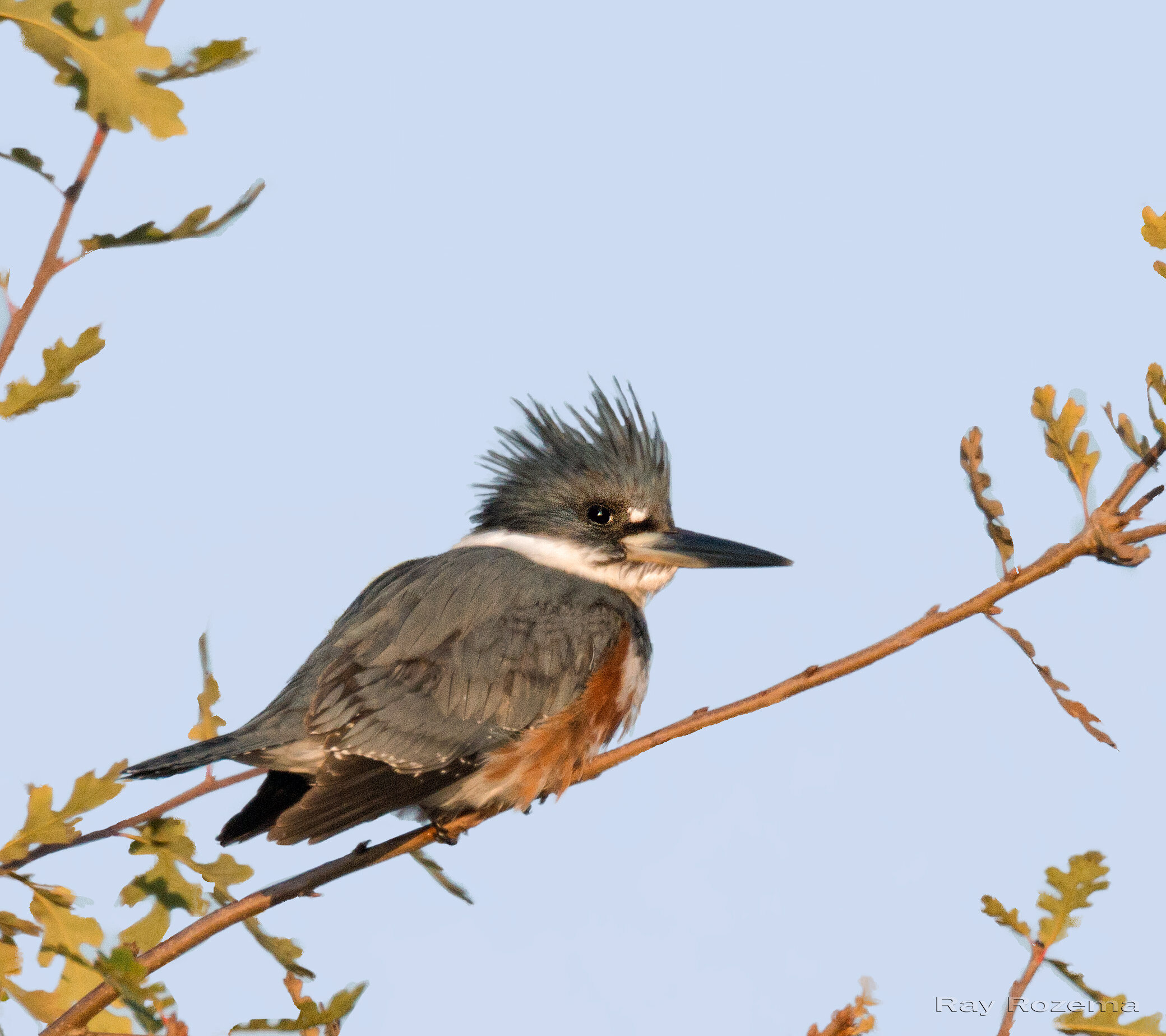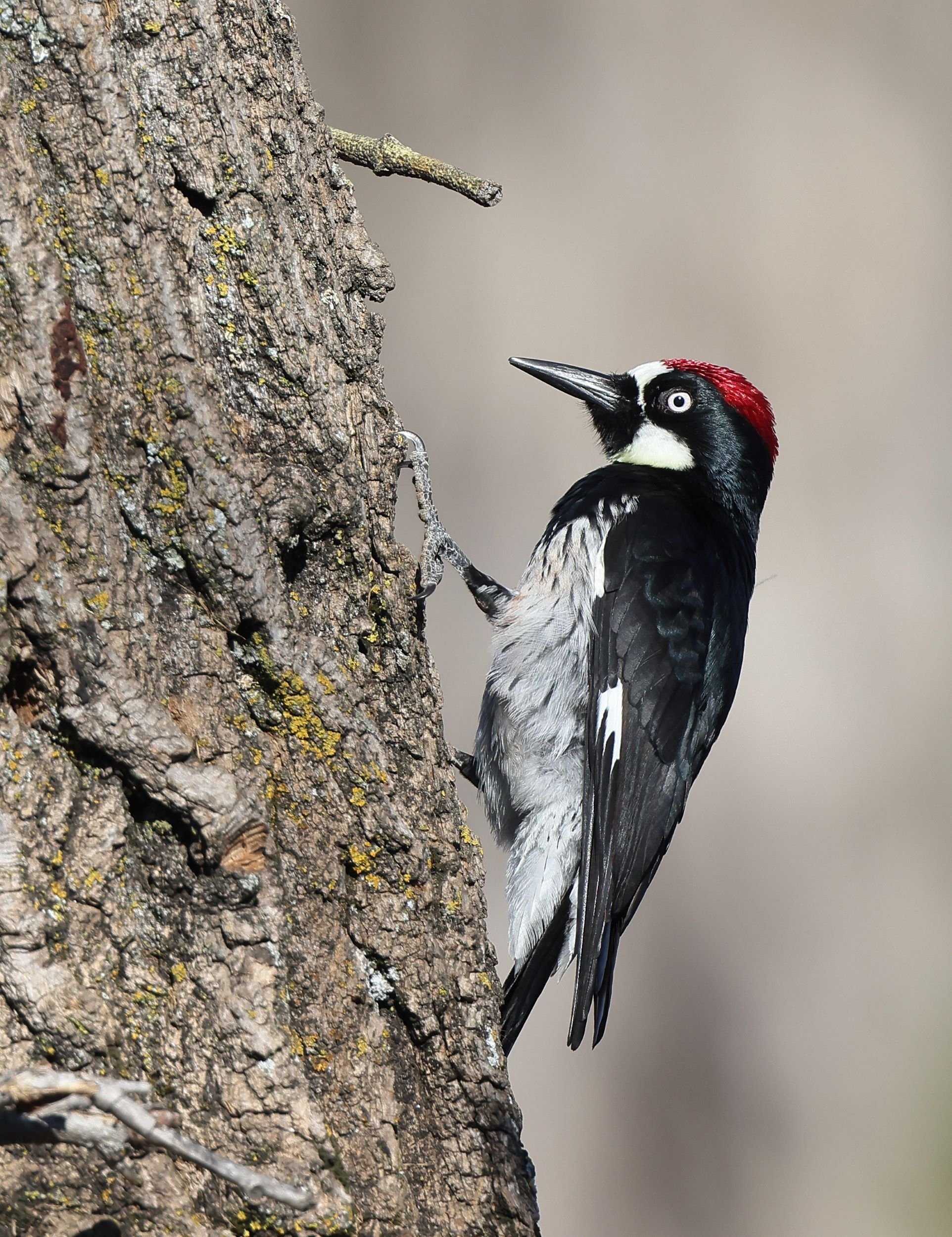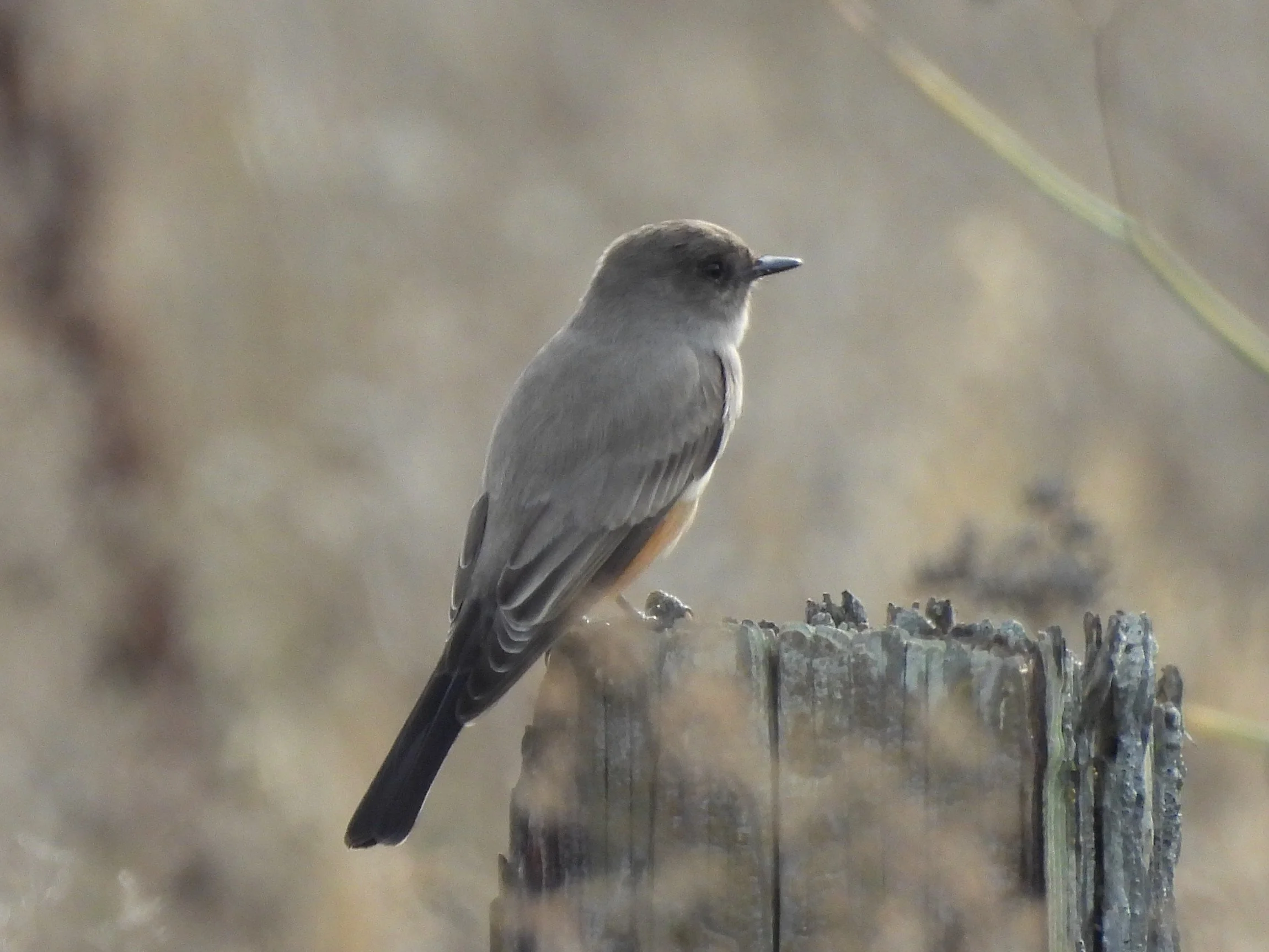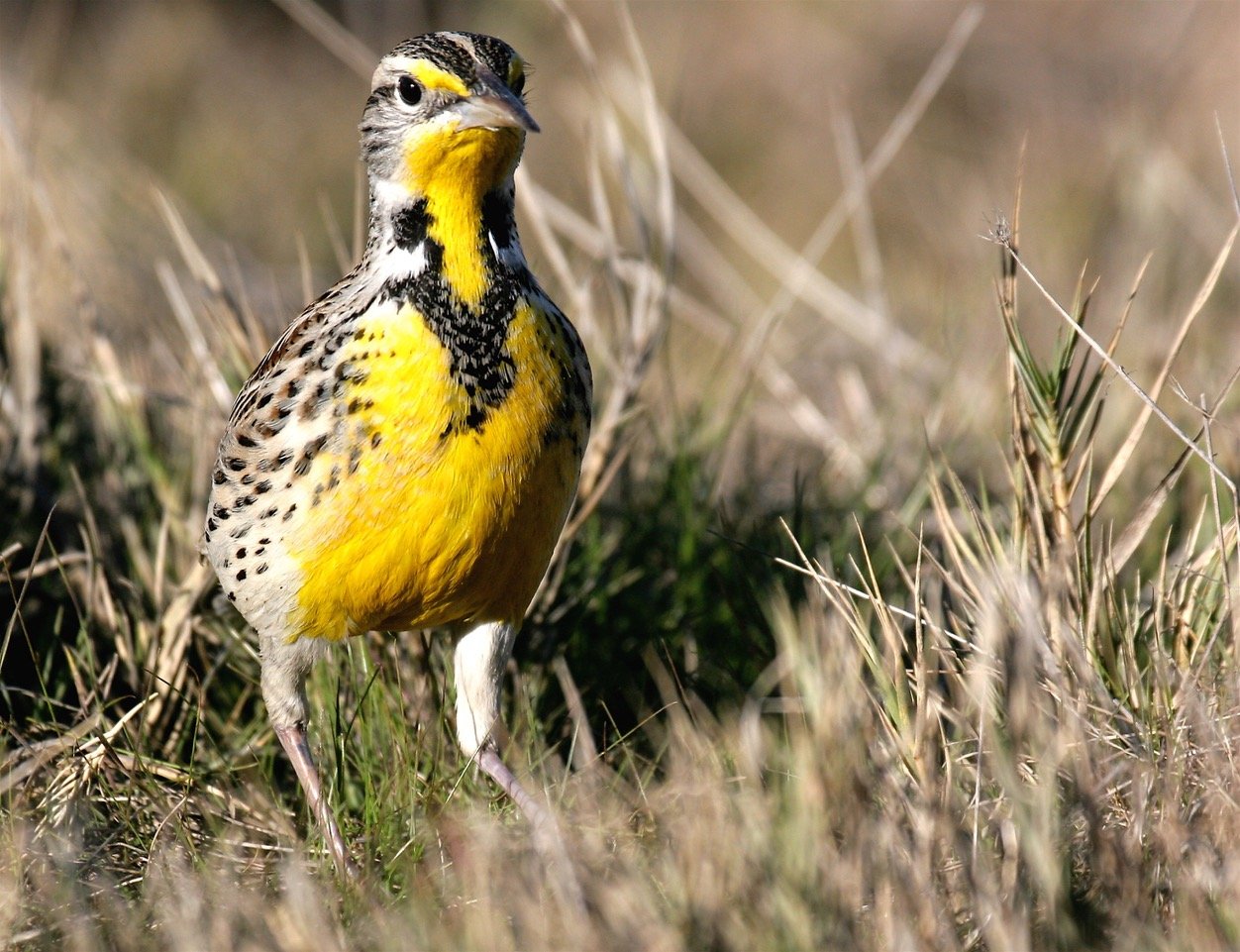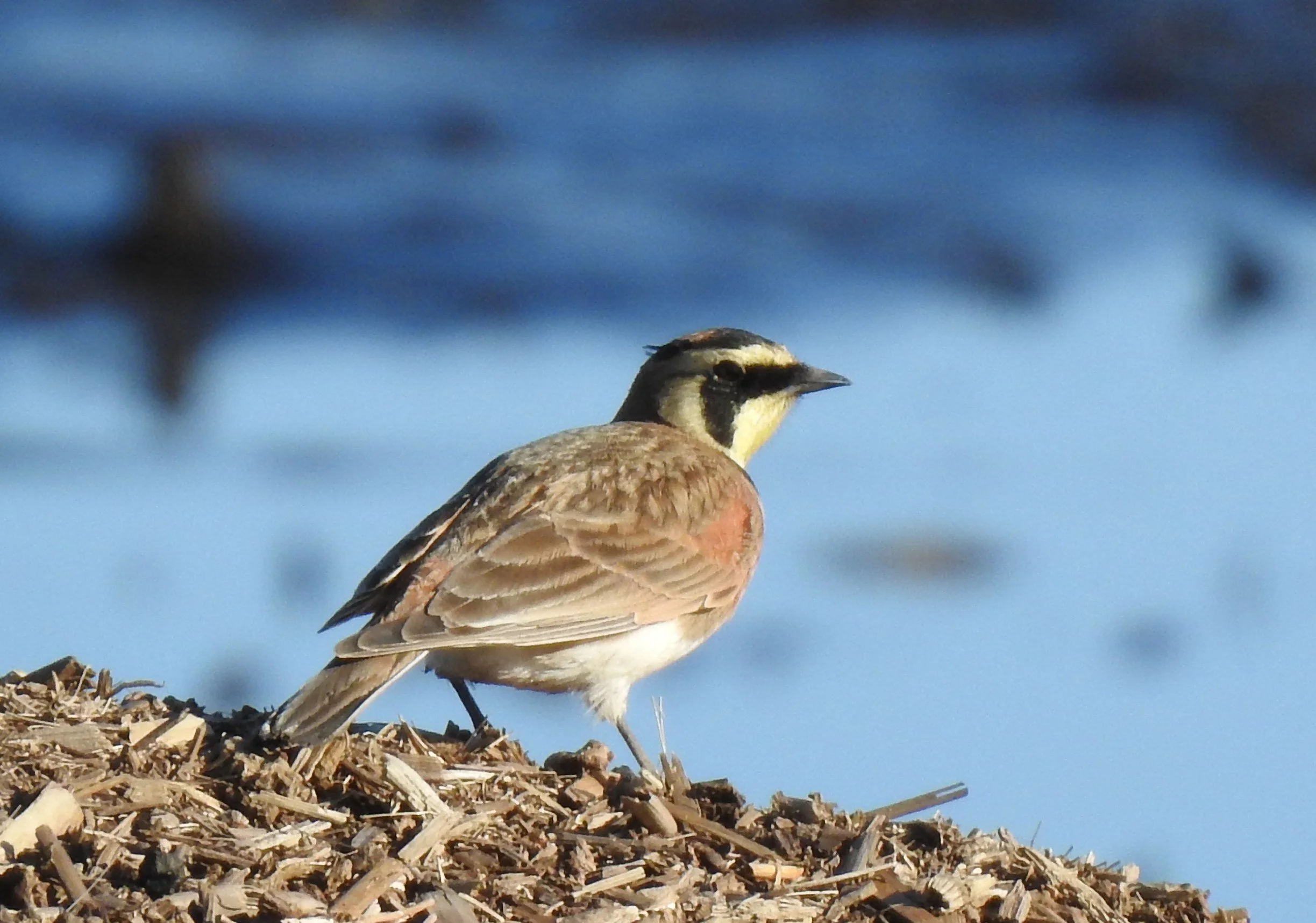SAS Field Trip: Del Campo Park, 10/8/25
Yellow-billed Magpie © Daniel Lee Brown
Leader Ed Harper reported: As our group was assembling at 8:00 AM, the rumble of trucks and equipment into the park told us we had company. The Carmichael Recreation and Parks Department had commissioned a private contractor to cut and trim trees. The September 3rd microburst had felled and damaged numerous trees in the park and the tree crew was in the clean-up mode. But today the mantra was to take out any tree with a dead branch. Chain saws out and about to take down some magnificent redwoods with dead spikes topping otherwise healthy trees, the crew paused as we approached and pleaded for them to spare the trees. As we talked, we pointed out a dozen or more Yellow-billed Magpies gathering atop the redwoods. Then a couple of Western Tanagers flew in, followed by eight more species of birds giving us ten species of birds that were drawn to these sentinel trees. The birds and our earnest pleading paused the operation, and the crew went elsewhere in the park to work. We completed our walk garnering 23 species in spite of the noise from saws and chippers. A major disappointment was to discover the granary established by a family of Acorn Woodpeckers was completely gone; just a pile of wood chips, sawdust, and shattered acorns. In spite of the challenging scenario, the group of eight eager and charming folks persisted to the end. Many were delighted to have discovered this park and its birding potential, and they will be even happier to learn that we have been successful and were informed the tree cutting has been called off. It’s too late for the many dead limbs that hosted nests for bluebirds, nuthatches, titmice, and woodpeckers, but maybe some nest boxes can help fill the gap until time heals the wounds.
SAS Field Trip: Cosumnes River Preserve, 10/11/25
White-tailed Kite © Daniel Lee Brown
Leader Cliff Feldheim reported: On October 11th, 8 of us enjoyed a nice morning at the Cosumnes River Preserve. We walked along the wetlands alongside Middle Slough and south to the River. We observed 32 species of birds. As the morning warmed up, we got good looks at some raptors, including a White-tailed Kite, American Kestrel, Northern Harriers, Red-Tailed and Red-shouldered Hawks, and a quick glimpse of a Cooper's Hawk. Although the warblers and songbirds were hard to come by, the wetlands had abundant Northern Pintail, Gadwall, American Wigeon, Green-winged Teal, Northern Shoveler, Mallard, Greater White-fronted Geese, and a handful of Cinnamon Teal. In the shallow waters/mud there were groups of Long-billed Dowitchers, Greater Yellowlegs and a smattering of Least and Western Sandpipers, with the occasional Black-neck Stilt. In addition to the birds, we enjoyed discussing the history and management of the Preserve, salmon ecology and waterfowl life history.
SAS Field Trip: Ancil Hoffman Park, 10/12/25
Leader Rachael Cowan reported: no report submitted.
SAS Field Trip: Reichmuth Park, 10/17/25
Cooper’s Hawk © Daniel Lee Brown
Leader Eric Johnson reported: Eight birders ranging from brand new to very experienced gathered at Reichmuth Park on October 17. People were hoping to see warblers, woodpeckers or “anything at all.” Our first hear was the Nuttall’s Woodpecker chitter-chatter, so an auspicious beginning. As we headed north into the canal trail, it was quiet. Too quiet. A Cooper’s Hawk sitting sentinel explained the lack of action. We backtracked and headed toward the oaks in the north, picking up several Ruby-crowned Kinglets, California Scrub-Jays, and Black Phoebes. Exiting the wooded area for the grass, we saw…nothing. Literally zero birds for five minutes while we stood there. We were just about ready to take it personally but determined to hold out hope. Venturing back toward the canal trail, we picked up a late Black-throated Gray Warbler, a lifer for several. On the canal, all was redeemed: White- and Golden-crowned Sparrows singing their hearts out, Hermit Thrushes (another lifer), a Fox Sparrow (lifer), Yellow-rumped Warblers, White-breasted Nuthatch, Cedar Waxwings, and others previously seen made the brush come to life. Despite a rocky beginning, we all left happy, with 28 species on a truly lovely morning.
Young Birders Club Field Trip: Tall Forest Survey, 10/19/25
American Barn Owl © Daniel Lee Brown
Leader Mackenzie Hollender reported: Two young birders and one parent met my father, John Trochet, Chris Conard and I on this chilly pre-dawn morning behind Nicolaus gate. We saw the silhouette of an American Barn Owl on a telephone wire, our first bird of the outing, and as we traveled farther into the agricultural fields and light rose in the sky, we noticed many more American Barn Owls hunting low over the fields. We arrived at the equipment pad while it was still pretty dark—hearing Great Horned Owls. We traveled towards the Love Shack and paused at the edge of a woodlot and farmland just in time for the dawn chorus to start—Song Sparrows, Marsh Wren, Virginia Rail are among some that we heard. We were awestruck by many small groups of Sandhill Cranes passing directly overhead and hundreds more Greater White-fronted Geese lifting from the fields. A Say’s Phoebe sat on a telephone wire, a White-tailed Kite passed overhead, and an American Kestrel landed in a nearby oak tree. A flock of about 20 Yellow-billed Magpies, known to roost here, landed at the top of a eucalyptus and stayed for a few minutes before taking off again. We briefly saw a Wilson’s Snipe descend rapidly and disappear into a field.
Lark Sparrow © Chris Conard
Moving on from the love shack, we headed down to the Accidental Forest, pausing to look at a Lark Sparrow, less common for this location, on a telephone wire. Arriving at the accidental forest, we were greeted by many Ruby-crowned Kinglets, vocal Downy Woodpeckers, sunning Turkey Vultures, and American Robins. Inside of the Accidental Forest, we picked up Hermit Thrush and Spotted Towhee. Emerging out of the thick forest and onto a dry sandbar, we noticed inconspicuous Golden-crowned Kinglets foraging in the oak canopy, calling softly. We briefly heard a Hutton’s Vireo, and realized we had a mixed flock. Upon Chris Conard’s imitation of a Northern Pygmy-Owl call, three Orange-crowned Warblers popped up along the forest edge, along with one Townsend’s Warbler. Many Wrentits sang, a lone Cackling Goose flew overhead, along with a Brown-headed Cowbird, and a Long-billed Curlew called in the distance. We left the Accidental Forest, then headed down along Wood Duck slough towards the Tall Forest, stopping along the way for another Townsend’s Warbler, an Acorn Woodpecker, Fox Sparrow, Wood Ducks flushing from the slough, Northern House Wren, and a Sharp-shinned Hawk that cruised just above the tree line. Due to time, we had to double back through Warbler Woods, where we picked up Western Bluebird, White-breasted Nuthatch, another Golden-crowned Kinglet flock with yet another Townsend’s Warbler, and a small flock of Oregon Dark-eyed Junco. Overall, it was a very diverse day full of exploration in a preserved, special natural area, and we learned a lot of natural history too!
SAS Field Trip: Nimbus Fish Hatchery, 10/21/25
Female Belted Kingfisher © Ray Rozema
Leader Molly Shea reported: Our group had a wonderful morning birding along the American River trail next to the Nimbus Fish Hatchery. We saw 42 species overall, many of which were recently arriving following the start of the Chinook salmon migration in the river. Highlights included a female Belted Kingfisher eating a crayfish, a great view of a male California Quail perch on top of a bush, and a unique view of a large flock of Cedar Waxwings eating insects high above us. Other species included White-throated Swifts, an Osprey, some territorial Great Egrets, many Double-crested Cormorants, and a variety of gull species (California, American Herring, and Ring-billed)!
SAS Field Trip: Sacramento Bar, 10/23/25
Acorn Woodpecker © Timothy Jackson
Leader Rich Howard reported: A nice blend of ten birders, from very new to decades of experience, braved a cool foggy start to the day along the American River. We were rewarded with good views of an interesting hybrid gull (we finally decided on American Herring x Glaucous-winged), Acorn Woodpeckers, and Cedar Waxwings. We found California Scrub-Jay, California Quail, California Gull, and the near-endemic Nuttall’s Woodpecker for a visitor from Virginia, and directed him to some good Yellow-billed Magpie spots nearby. Snowy and Great Egrets offered nice side-by-side comparison looks in the scope, but a Green Heron that landed near them was a bit harder to see. Diving ducks had not returned to the river, so we headed inland and had a nice showing of Turkey Vultures, Cooper’s and Sharp-shinned Hawks, and White-throated Swifts in the air. Returning winter visitors were nice to see, including Dark-eyed Junco, Yellow-rumped Warbler, and American Robin. San Juan Rapids gave us our first Double-crested Cormorants, two Killdeer, and a perched American Herring Gull in good light. A good morning and a good group. A participant generously kept our eBird list; it can be found here: https://ebird.org/checklist/S280977759
SAS Field Trip: Sailor Bar, 10/25/25
American Herring Gull © Mary Forrestal
Leaders Mary Forrestal and Jane Van Kessel reported: The overcast skies and possibility of rain didn’t keep 13 birders from joining us on this Saturday morning field trip along the American River. Bird sound proceeded sightings, but we were soon rewarded with looks at Oak Titmice, Yellow-rumped Warblers, Ruby-crowned Kinglets, a White-breasted Nuthatch, and a Nuttall’s Woodpecker. At our first river overlook, across from Nimbus Fish Hatchery, an Osprey provided excitement along with Double-crested Cormorants, Ringed-billed and California Gulls, Great Egrets and our first Common Merganser. White-crowned Sparrows provided background music for most of the walk. The burbling of California Quails was realized when a small group was seen by the boat launch. Here we were also rewarded with up-close looks at an American Herring Gull, showing pink legs while seeming to pose on a rock, and a Snowy Egret who seemed to take offence at the gulls’ position. Further down the river, we enjoyed a Spotted Sandpiper, numerous Turkey Vultures, a male Bufflehead, a female Shoveler, and two Gadwall. Perhaps the sighting of the day was two Sharp-shinned Hawks chasing each other about and posing in trees. It was altogether a good raptor day with two Red-shouldered Hawks, a Red-tailed Hawk, a Cooper’s Hawk, two American Kestrels, and a Bald Eagle seen in addition to the Sharpies. You can see the complete eBird list here: https://ebird.org/checklist/S281313469.
Beginning Birder Walk: William Pond Park, 10/26/25
Northern Flicker © Dana J. Miller-Blair
Leader Larry Hickey reported: Despite a sprinkling of early morning rain, eight beginning birders joined us on a late October morning at the William Pond section of the American River Parkway. Right away we had excellent views of male and female Northern Flickers, Black Phoebe and Yellow-billed Magpies once they were spotted on the road by one of our beginning birders. We saw and heard several Red-shouldered Hawks and mostly heard White-crowned Sparrows and Ruby-Crowned Kinglets. We saw several flocks of Cedar Waxwings and enjoyed good views of a Great Blue Heron. Highlights were side-by-side views of a Great Egret and Snowy Egret and excellent views of a cooperative male American Kestrel.
SAS Field Trip: River Bend Park, 10/30/25
Oak Titmouse © Dana J. Miller Blair
Leader Dana Miller-Blair reported: 8 of us met on a lovely clear autumn morning for birding in River Bend Park. We walked up river through the woods and back down along the riverbank. We saw only a few other people in the park, but leaf blowers in the distance made birding by ear difficult at times. Our day started with Western Bluebirds near the parking lot. Approaching the bicycle bridge, we were rewarded with a distant view of my first of season Phainopepla. Oak Titmouse, White-crowned Sparrows, Golden-crowned Sparrows, Ruby-crowned Kinglets, Acorn Woodpeckers and California Scrub-Jays and Mourning Doves were numerous throughout the walk. Standout species in the woods included a Lark Sparrow, a Hutton's Vireo, and 3 Red-breasted Sapsuckers. We also enjoyed seeing a Cooper's Hawk fly by, and a perched Red-shouldered Hawk afforded good views. Also in the woods, we heard California Quail, and a Downy Woodpecker. We saw and heard many Northern Flickers, a few American Crows, many Bushtits, a few European Starlings, 4 American Robins, many Cedar Waxwings, a large flock of Lesser Goldfinches, 4 California Towhees, 3 Spotted Towhees, a few House Finches, Anna's Hummingbirds, a couple each of White-breasted Nuthatches and Bewick's Wrens, along with a House Wren and one Yellow-rumped Warbler. Turning to the River, we enjoyed counting 26 Killdeer on 2 rock islands, and saw a couple of Spotted Sandpipers, a Belted Kingfisher, along with several Canada Geese, Mallards, a couple Common Mergansers, a few Black Phoebes, 2 Great Egrets, 8 Turkey Vultures and 3 American Herring Gulls. We carefully examined the trees on the opposite shore looking for Bald Eagles (which are often perched on the tall trees on the north side of the river) but didn't see them today. We appreciated having Jim Joye carrying his scope along so we could carefully examine and identify the more distant perched birds.
SAS Field Trip: Michigan Bar, 11/1/25
Say’s Phoebe © Mary Forrestal
Leader Chris Conard reported: We had beautiful weather and an enjoyable outing to a couple of the Sacramento area's best open spaces. We started at Michigan Bar Rd, with an immature Bald Eagle and a Wilson's Snipe at the Cosumnes River Bridge, where we also viewed salmon in the river. We had Lark Sparrows in addition to regular foothills species, but Lewis's Woodpeckers, rare sparrows, and additional uncommon raptors were elsewhere. As we moved to Meiss Rd, the lack of uncommon raptors mostly continued. Between the two locations, we recorded over 15 Say's Phoebes. After several flybys, we finally found an observable flock of Horned Larks. We scanned several traditional Burrowing Owl sites without luck, but accidentally flushed one from a pile of dumped roadside trash. Unfortunately, it flew into tall vegetation, not allowing much of a look.
Young Birders Club Field Trip: Staten Island Road, 11/1/25
Western Meadowlark © Ed Harper
Leader Mackenzie Hollender reported: Three young birders and three parents met my father and I along this farmland road. We parked at a spot where an open grassland lay to our right, and a flooded ag field to our left. In the grassland, an American Kestrel sat perched on a fenceline, Western Meadowlarks flew up from the grass clumps to cross to another spot in the field, and White-crowned Sparrows hopped up from a patch of blackberry lining the road. In the flooded field, we enjoyed beautiful long looks at preening Sandhill Cranes, resting Cackling Geese, and we viewed a pair of Green-winged Teal through a scope. A Northern Harrier sailed along a horizontal strip of vegetation, and Brewer’s and Red-winged Blackbird flocks moved overhead. A Greater Yellowlegs called and flew across the field, and a Ring-billed Gull flew in and landed, carrying a Crawfish, which it began to hack into with its bill upon landing. We inched our way down the road, pausing for more kestrels, Snowy Egrets, and an empty dirt field to catch a glimpse of American Pipits walking among a flock of Killdeer.
Cackling Goose © Daniel Lee Brown
Our next full stop was at a long, flat grassy field that was absolutely covered in Cackling Geese. We estimated 7,000 Cackling Geese just in this field and picked out many minima subspecies among the more common aleutions subspecies. A Great Egret flew into the beginning on the field, interestingly, causing some of the Cackling Geese around it to fly up and land farther away from it, leaving the egret with a wide area of the field devoid of Cackling Geese, to itself. A few minutes later, a Ring-billed Gull crossed into the field, and flew around the far right area. This caused a great stir in the Cackling Geese, and in a domino effect, starting with the geese nearest to the gull, the majority of the 7,000 bird flock lifted off the field. It was an incredible sight, and deafeningly loud too. We noted that we could feel vibrations in the ground when the flock lifted off. The birds filled all corners of the sky and surrounded us, heading in all directions. We watched, mesmerized. After the geese had settled, we traveled onward, picking up White-tailed Kites that traveled south, flocks of Greater White-fronted Geese, and watched more Sandhill Cranes foraging in dry fields.
Horned Lark © Mary Forrestal
A large dirt pullout on the side of the road revealed Horned Larks, many adults with the beautiful creamy yellow face and striking black masks. We noticed one where the wispy ends of the black masks extended slightly up from the top of the head. We continued to a large flooded field with very little vegetation, where a flock of American Coots foraged. Through a scope, we picked out a female Canvasback, two Eared Grebe, and a female Ring-necked Duck among the coot flock. It was around six, and the sun was setting fast when, behind us, we spotted an American Barn Owl coursing just above a strip of vegetation that divided the fields in a buoyant mystical flight. Further down the road, a field that was shallowly flooded with small stalks of new grass revealed Dunlin, Least Sandpiper, and two Wilson’s Snipe. A second Barn Owl foraged the same way as the first and crossed unusually high above the flooded field to get to another vegetation strip. We arrived at the old water tower at 6:20 and waited around for a chance of seeing a great horned owl, instead seeing yet another foraging American Barn Owl, and hundreds of waterfowl flying against a deep red sunset to end off the extremely well rounded, beautiful evening. Savannah Sparrow and Red-tailed Hawk were two other highlights.
SAS Field Trip: Gibson Ranch, 11/2/25
Chipping Sparrow © Daniel Lee Brown
Leader Kevin Thomas reported: A wonderful morning on the first day of the fall back time change. We started a half hour after sunrise while there was still a bit of fog sticking to the ground and temperatures were in the low 50s. We were greeted in the parking lot by White-breasted Nuthatch and a flock of Bushtits and Kinglets. We worked our way along the pond edge and heard Marsh Wren singing and saw flocks or Red-winged and Brewer's Blackbirds. As we passed along a group of tule and came within view of the shallow grass edge we flushed up a Wilson's Snipe that took off up and out of view. Following the Snipe, we heard the grunt of a Virginia Rail coming from deep inside the tule patch. We made our way over to scan the grasslands and a pair of White-tailed Kites were hanging out on the barbed wire fence. We made our way through the grassy park area and picked up many Dark-eyed Junco, White-crowned Sparrow, and House Finches. A lone Chipping Sparrow hanging out with the other birds forging in the grass was a treat. The riparian area was slow this morning with a few Hermit Thrush calling but never coming into view and Acorn Woodpeckers caching acorns in the dead cottonwood snags. We worked our way along the trail parallel to the horse stables and had great looks at a Red-breasted Sapsucker. It was just above eye level for several minutes foraging on the oak tree trunks. We had a fantastic morning with a great group of 7 birders who were happy to share sightings and stories with all.
SAS Field Trip: Cosumnes River Preserve, 11/8/25
Leader Cliff Feldheim reported: On November 8, 13 of us had a nice walk around the Cosumnes Preserve primarily along the River Walk Trail. After the fog lifted, we were treated to waves of Greater White-fronted Geese with about 1,500 landing in a nearby pond. We got nice looks at a Cooper’s and a Sharp-shinned Hawk as well as a Merlin and distant Bald Eagle. There was a relatively big group of 25 Cinnamon Teal in one pond, and we were able to see Cinnamon, Blue-winged, and Green-winged Teal all standing next to each other. In total we enjoyed seeing 47 species of birds and great conversation about conservation, ecology, and the history/management of the Cosumnes Preserve.
Cinnamon Teal © Larry Hickey

